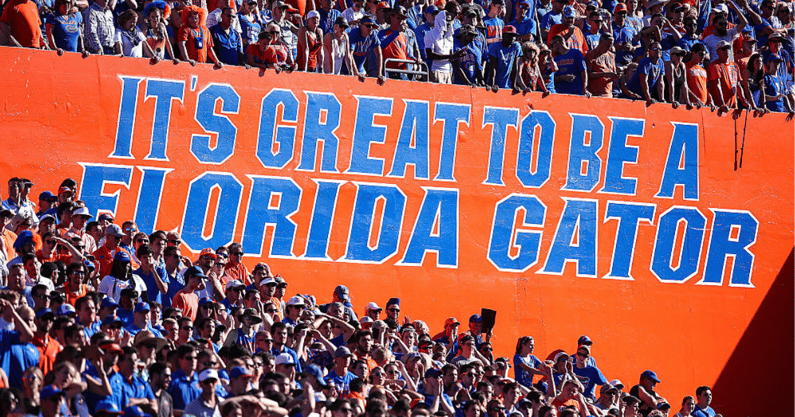Florida NIL collective’s deal with school is template others could follow

As donor-led NIL collectives gain momentum nationwide, some current and former college sports administrators are voicing the quiet part out loud regarding concerns.
If deep-pocketed boosters now invest much of their funds into collectives — with those monies compensating athletes in NIL deals — will the same supporters contribute as much as they typically do to athletic departments? The question takes on heightened importance these days with contributions down substantially at many schools because of the COVID pandemic. For instance, those made to LSU football reportedly dropped by $15.78 million during the fiscal year 2020-21.
Former Tennessee coach and athletic director Phil Fulmer, who is a founding advisory board member with Athlete Licensing Company, expressed a sentiment with On3 that other sources have echoed, saying, “That’s an area I’m a bit concerned about, people [boosters] putting money into these collectives, and universities all of the sudden aren’t getting those dollars for facilities or scholarship dollars. It could affect it.”
Mit Winter, a Kansas City-based sports attorney, told On3 that he recently talked with an administrator at a mid-major who went as far as to say he hopes a NIL collective is not formed for his school because he needs all of that money to fund his athletic program and doesn’t want any going to a collective.
Against that backdrop, one innovative way to address the issue emerged this week. In a first-of-its-kind partnership, the University of Florida announced that the Gator Collective is a new sponsor of the Gators. The announcement makes clear that the sponsorship between Florida athletics and the Gator Collective is separate from any activity related to funds that may be allocated to athletes as part of NIL opportunities.
With the partnership, the collective pays money to become an official athletic department sponsor. In return, the collective receives enhanced exposure, potentially anything from venue signage to digital engagement and visibility through the school’s official athletics website as well as radio game broadcasts and coaches’ shows. It could also give the collective the ability to use Florida’s intellectual property (IP) — meaning trademarks — in NIL deals for athletes, which greatly enhances merchandise and activations.
For the collective, the athletes and the school, it is a big win.
Prominent Florida-based sports attorney Darren Heitner told On3 in an email that he agreed that the partnership benefits both parties. The Gator Collective retained Heitner to provide legal counsel and ensure NIL compliance. But Heitner, who also teaches at Florida’s law school, takes exception to the notion that collectives divert booster funds that otherwise would go to athletic departments, saying, “There is simply no foundation for the thinking that boosters will shift monies traditionally reserved for athletic departments to these collectives. From what I have seen, boosters have maintained their existing contribution patterns and some have supplemented it with payments to players through NIL vehicles.”
Nevertheless, Winter said to expect more of these unique partnerships as the NIL landscape with collectives continues to take shape.
Top 10
- 1New
Bowl Projections
Full list of matchups
- 2
Top Target: Kiffin
Why UF should pursue Ole Miss HC
- 3Hot
Coaching Carousel
Hot seat intel
- 4Trending
Shane Beamer
Denies Hokies rumors
- 5
AP Poll
Massive shakeup in Top 25
Get the Daily On3 Newsletter in your inbox every morning
By clicking "Subscribe to Newsletter", I agree to On3's Privacy Notice, Terms, and use of my personal information described therein.
“For the universities, their fear of money being siphoned away to the collectives is alleviated somewhat, since at least some of that money is coming to the university via the sponsorship deal with the collective,” Winter said. “And for the collectives, they will get increased exposure to fan bases through in-game advertising, which will likely result in more money coming into the collective. So these deals also end up being a win for a university’s athletes because the more money a collective has, the more money it can distribute to athletes via NIL deals.”
What’s more, these deals likely will result in more co-branded merchandise and events, where an athlete’s NIL is used in connection with a university’s trademarks. That also benefits the athletes and school because both parties will receive licensing royalties.
Some schools have drafted their NIL policies to specifically address the issue of donor and potential sponsor money going to athletes instead of the athletic department, Winter said. The policies don’t allow businesses to use school trademarks and other IP in connection with an athlete NILs unless the business is an athletic department sponsor. One business Winter represents has a license from the university to use the school’s trademarks on apparel, but because it’s not an official athletics department sponsor, it can’t use the trademarks in connection with athlete NILs.
Sponsorship has its privileges, and donor-led collectives are taking notice.
As it relates to the Florida sponsorship specifically, all of the Gators’ sponsorships are managed by Learfield’s Florida Gators Sports Properties, the multimedia rights holder and sports marketing arm for the athletic department. Learfield represents the Gators, not their student-athletes. The Gator Collective seeks to provide fans with access to — and experiences with — Florida’s athletes. Fans commit to a monthly pledge, starting at $5.99 per month, to receive exclusive content that includes autographs, interviews, social media content and appearances. The collective, in turn, then compensates those athletes.
With the partnership this week, the Gator Collective will receive enhanced visibility in front of the fans targeted to contribute to the collective, as well as unlock potential to use the school’s trademarks in NIL deals. In return, the athletic department will receive monies that otherwise would have been siphoned only to the collective. Athletes still benefit financially. So do schools.
In a unique school-collective partnership, Florida has established a template that others almost certainly will try to duplicate.